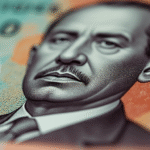Background on Key Figures and Institutions
The article discusses a statement made by Alejandro Saldaña, the Chief Economist of BX+, regarding the current economic situation in Mexico. BX+ is a financial analysis firm, and Saldaña’s insights are significant due to his expertise in the Mexican economy.
The central bank of Mexico, known as Banco de México (Banxico), is responsible for managing the country’s monetary policy. Its decisions on interest rates have a substantial impact on inflation, economic growth, and the Mexican peso’s value.
Current Economic Challenges
Trade Uncertainty:
The global trade environment remains uncertain, with ongoing negotiations and potential shifts in international commerce policies affecting Mexico’s economy. This uncertainty makes it challenging for Banxico to predict the future trajectory of key economic indicators.
Rising Inflation:
Mexico has experienced three consecutive months of rising inflation, driven by factors such as currency depreciation and increased costs for imported goods. These pressures are further exacerbated by labor cost increases that do not align with productivity improvements.
Currency Depreciation and Imported Goods
Saldaña highlighted that currency depreciation raises the cost of imported inputs and goods, with non-food commodities and producer prices being particularly sensitive to these fluctuations.
Labor Cost Pressures
The economist also pointed out that isolated labor reforms, such as additional vacation days, have led to structural issues without corresponding productivity gains.
Banxico’s Monetary Policy and Future Outlook
According to Saldaña, the Banco de México’s governing board will likely adopt a cautious approach in the second half of the year, closely monitoring international trade conditions and the U.S. Federal Reserve’s (Fed) decisions on interest rates.
He anticipates that the Federal Open Market Committee will reduce interest rates twice before the end of the year, widening the interest rate differential and putting additional pressure on the Mexican peso.
Saldaña’s Interest Rate Projection
Based on these expectations, Saldaña forecasts that the U.S. dollar will trade at 20 Mexican pesos by year-end.
Key Questions and Answers
- What is the current economic situation in Mexico? Mexico faces trade uncertainty and rising inflation, with currency depreciation increasing the cost of imported goods and labor cost pressures without productivity improvements.
- Who is Alejandro Saldaña and why is his opinion important? Alejandro Saldaña is the Chief Economist of BX+, a financial analysis firm. His insights are crucial due to his expertise in the Mexican economy and the influence of his opinions on monetary policy decisions.
- What is Banco de México (Banxico) and what role does it play? Banco de México is Mexico’s central bank, responsible for managing the country’s monetary policy. Its decisions on interest rates significantly impact inflation, economic growth, and the Mexican peso’s value.
- What is Saldaña’s outlook for Banxico’s monetary policy? Saldaña expects Banxico to adopt a cautious approach, closely monitoring international trade conditions and the U.S. Federal Reserve’s decisions before making any interest rate adjustments.
- What is Saldaña’s prediction for the U.S. dollar-Mexican peso exchange rate by year-end? Saldaña forecasts that the U.S. dollar will trade at 20 Mexican pesos by the end of the year.






